|
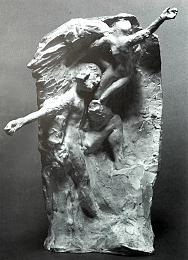 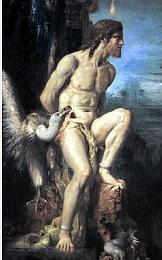 'The Torture of Prometheus', painted by Gustave Moreau
in 1868,
shows the harrassed Titan in a pose foreboding Rodin's sculpture, 'The Poet and Love' (plaster, 1896, Philadelphia
Rodin Museum), one of the allegorical studies of the 1890's on the relationship
between the gifted artist and his muse. Within 'The Torture of Prometheus', painted by Gustave Moreau
in 1868,
shows the harrassed Titan in a pose foreboding Rodin's sculpture, 'The Poet and Love' (plaster, 1896, Philadelphia
Rodin Museum), one of the allegorical studies of the 1890's on the relationship
between the gifted artist and his muse. Within  Rodin's
work, this typical pose with one leg
pulled up, head and upper body bent slightly forward, can be traced back to his 'Polyphem' and in 1905-06 was
employed again in 'Whistler's Muse', representing 'Venus climbing the
Mountain of Fame'.
'The Poet and Love' later became the basis for Rodin's
proposed 'Monument to Eugène Carriere. (1912, plaster, Philadelphia). Rodin's
work, this typical pose with one leg
pulled up, head and upper body bent slightly forward, can be traced back to his 'Polyphem' and in 1905-06 was
employed again in 'Whistler's Muse', representing 'Venus climbing the
Mountain of Fame'.
'The Poet and Love' later became the basis for Rodin's
proposed 'Monument to Eugène Carriere. (1912, plaster, Philadelphia).
As already discussed with regard to 'The Genius and
Pity' (1895, also called 'Prometheus and the Oceanid' or 'Christ and Mary
Magdalene'), artists of the late Nineteenth Century often identified
themselves with Prometheus, the gifted Titan who had revolted against Zeus
and stolen the fire from the Olympus to bring it back to mankind. 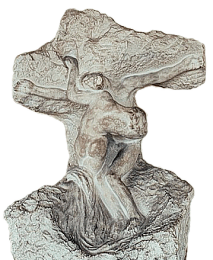 Prometheus
was cruelly punished, still declined any compromise Zeus offered him, till
he was finally released by Hercules. During Rodin's time, the character of
Prometheus was widely acccepted as the prototype of artistic genius,
obeying solely its own high principles, suffering for the good of
humanity. In 'The Poet and Love', the eagle or vulture daily picking at
the chained hero's liver is replaced by another winged creature: the
Poet's Muse, offering affection, inspiration and consolation. Prometheus
was cruelly punished, still declined any compromise Zeus offered him, till
he was finally released by Hercules. During Rodin's time, the character of
Prometheus was widely acccepted as the prototype of artistic genius,
obeying solely its own high principles, suffering for the good of
humanity. In 'The Poet and Love', the eagle or vulture daily picking at
the chained hero's liver is replaced by another winged creature: the
Poet's Muse, offering affection, inspiration and consolation.
Rodin extensively
explored this subject while working on his 'Monument to Victor Hugo'
(1889-1897) and apart from his efforts for this commissioned work, he
created a series of private studies circling around the same theme. In
1980, Elsen already pointed to the difficulties in Rodin's professional
and personal life in the 1890's to explain the sculptor's intensive
occupation with this motif: the rejection of his first design of the
'Monument to Victor Hugo', the severe critique of his 'Monument to Claude
Lorraine', the difficulties regarding the execution and installment of
'The Burghers of Calais', and last but not least the rupture in his
relationship with Camille Claudel.
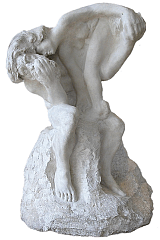 In
still another work,'The Sculptor and his Muse' (1895-97), the Muse is more
than just comforting. Not only does she whisper in the artist's ear: with
her hand caressing the sculptor right between his legs
, she appears above all as sexually stimulating.
As documented by de Caso/Sanders, Rodin at various occasions expressed his
opinion that sexuality and genius were closely related: In
still another work,'The Sculptor and his Muse' (1895-97), the Muse is more
than just comforting. Not only does she whisper in the artist's ear: with
her hand caressing the sculptor right between his legs
, she appears above all as sexually stimulating.
As documented by de Caso/Sanders, Rodin at various occasions expressed his
opinion that sexuality and genius were closely related:
"I have heard the bellowing of my spirit in battle for
woman. I have spied on myself in my moments of passion, of the
intoxication of love, and I have studied them for my art.."
The sculptor expressly agreed with Baudelaire
"...that a man's sexual sensitivity measures his genius."
For Rodin, the Muse was not an ethereal, volatile entity, but a woman of
flesh and blood, not an allegorical abstraction, but a powerful person.
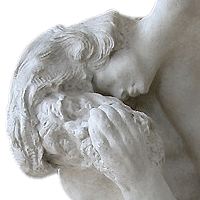 In
'The Sculptor and his Muse', Rodin demonstrates how overwhelming this
power can be: The hair of the Muse is flowing over the sculptor's head,
his upper body bends over under her pressure, his face is distorted, not
only with pleasure, but also with pain, as if tormented in the moment of
highest lust. The Muse's ability to arouse and stimulate is not merely a
grace: it also constitutes the artist's dependency, exhausting him while
she spurs him on, leaving him empty and desperate when she's absent. In
'The Sculptor and his Muse', Rodin demonstrates how overwhelming this
power can be: The hair of the Muse is flowing over the sculptor's head,
his upper body bends over under her pressure, his face is distorted, not
only with pleasure, but also with pain, as if tormented in the moment of
highest lust. The Muse's ability to arouse and stimulate is not merely a
grace: it also constitutes the artist's dependency, exhausting him while
she spurs him on, leaving him empty and desperate when she's absent.
Antoinette le Norman-Romain observed a similarity
between the man's face and 'The Mask of the Man with the Broken
Nose';
the female figure is evidently derived from 'The Shell and the Pearl' ('La Coquille et la Perle'),
now turned upright. The work was carved in marble;
an early bronze cast is in the Spreckels Collection, San Francisco.
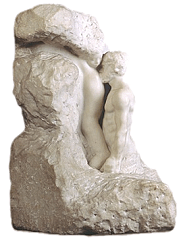 A
further work to be discussed in this context is 'The Man and his Thought'
(marble, Nationalgalerie, Berlin),
showing a bearded man of mature age, kneeling in front of a young girl.
Like in 'The Eternal Idol', inspiration is presented here in the shape of
mute adoration; the association with 'The Eternal Idol' is confirmed by
the alternative title 'The Host' ('La Hostie'), which Rodin used for both
of the groups. A
further work to be discussed in this context is 'The Man and his Thought'
(marble, Nationalgalerie, Berlin),
showing a bearded man of mature age, kneeling in front of a young girl.
Like in 'The Eternal Idol', inspiration is presented here in the shape of
mute adoration; the association with 'The Eternal Idol' is confirmed by
the alternative title 'The Host' ('La Hostie'), which Rodin used for both
of the groups.
The marble carving was exhibited at the Salon de Nationale of 1896
and later acquired by Felix Koenigs, who presented it to the Nationalgalerie
in Berlin. Apart from a "simple enough symbolism, highly appreciated by
the German public" (Antoinette le Norman-Romain), the composition can
be interpreted as an expression as Rodin's veneration of Nature, the
source of all artistic inspiration, represented here by the standing maiden
figure.
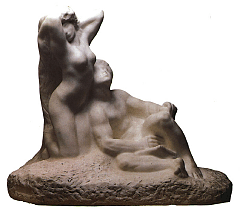 The
last work to be mentioned here is named 'The Poet and his Muse', probably
carved around 1905 and now exhibited in the Hermitage Museum. Judging it
by its name, we might associate it with the other discussed works, that
all were created around 1895-96. The expression of the group differs
completely from these earlier works, however. We find neither consolation,
nor sexual excitement, nor torment, nor adoration. This combination of
'Toilette of Venus' with a sitting young man is rather characterised by lack of tension; instead of symbolizing the hardship of artistic
struggle, it suggests a scene of bucolic leisure, the kneeling woman added
more as an ornament and pillow for the poet's head than as an inspiring and demanding
spiritual companion. The
last work to be mentioned here is named 'The Poet and his Muse', probably
carved around 1905 and now exhibited in the Hermitage Museum. Judging it
by its name, we might associate it with the other discussed works, that
all were created around 1895-96. The expression of the group differs
completely from these earlier works, however. We find neither consolation,
nor sexual excitement, nor torment, nor adoration. This combination of
'Toilette of Venus' with a sitting young man is rather characterised by lack of tension; instead of symbolizing the hardship of artistic
struggle, it suggests a scene of bucolic leisure, the kneeling woman added
more as an ornament and pillow for the poet's head than as an inspiring and demanding
spiritual companion.
|

 'The Torture of Prometheus', painted by Gustave Moreau
in 1868,
shows the harrassed Titan in a pose foreboding Rodin's sculpture, 'The Poet and Love' (plaster, 1896, Philadelphia
Rodin Museum), one of the allegorical studies of the 1890's on the relationship
between the gifted artist and his muse. Within
'The Torture of Prometheus', painted by Gustave Moreau
in 1868,
shows the harrassed Titan in a pose foreboding Rodin's sculpture, 'The Poet and Love' (plaster, 1896, Philadelphia
Rodin Museum), one of the allegorical studies of the 1890's on the relationship
between the gifted artist and his muse. Within  Rodin's
work, this typical pose with one leg
pulled up, head and upper body bent slightly forward, can be traced back to his 'Polyphem' and in 1905-06 was
employed again in 'Whistler's Muse', representing 'Venus climbing the
Mountain of Fame'.
'The Poet and Love' later became the basis for Rodin's
proposed 'Monument to Eugène Carriere. (1912, plaster, Philadelphia).
Rodin's
work, this typical pose with one leg
pulled up, head and upper body bent slightly forward, can be traced back to his 'Polyphem' and in 1905-06 was
employed again in 'Whistler's Muse', representing 'Venus climbing the
Mountain of Fame'.
'The Poet and Love' later became the basis for Rodin's
proposed 'Monument to Eugène Carriere. (1912, plaster, Philadelphia).
 Prometheus
was cruelly punished, still declined any compromise Zeus offered him, till
he was finally released by Hercules. During Rodin's time, the character of
Prometheus was widely acccepted as the prototype of artistic genius,
obeying solely its own high principles, suffering for the good of
humanity. In 'The Poet and Love', the eagle or vulture daily picking at
the chained hero's liver is replaced by another winged creature: the
Poet's Muse, offering affection, inspiration and consolation.
Prometheus
was cruelly punished, still declined any compromise Zeus offered him, till
he was finally released by Hercules. During Rodin's time, the character of
Prometheus was widely acccepted as the prototype of artistic genius,
obeying solely its own high principles, suffering for the good of
humanity. In 'The Poet and Love', the eagle or vulture daily picking at
the chained hero's liver is replaced by another winged creature: the
Poet's Muse, offering affection, inspiration and consolation.  In
still another work,'The Sculptor and his Muse' (1895-97), the Muse is more
than just comforting. Not only does she whisper in the artist's ear: with
her hand caressing the sculptor right between his legs
, she appears above all as sexually stimulating.
As documented by de Caso/Sanders, Rodin at various occasions expressed his
opinion that sexuality and genius were closely related:
In
still another work,'The Sculptor and his Muse' (1895-97), the Muse is more
than just comforting. Not only does she whisper in the artist's ear: with
her hand caressing the sculptor right between his legs
, she appears above all as sexually stimulating.
As documented by de Caso/Sanders, Rodin at various occasions expressed his
opinion that sexuality and genius were closely related: In
'The Sculptor and his Muse', Rodin demonstrates how overwhelming this
power can be: The hair of the Muse is flowing over the sculptor's head,
his upper body bends over under her pressure, his face is distorted, not
only with pleasure, but also with pain, as if tormented in the moment of
highest lust. The Muse's ability to arouse and stimulate is not merely a
grace: it also constitutes the artist's dependency, exhausting him while
she spurs him on, leaving him empty and desperate when she's absent.
In
'The Sculptor and his Muse', Rodin demonstrates how overwhelming this
power can be: The hair of the Muse is flowing over the sculptor's head,
his upper body bends over under her pressure, his face is distorted, not
only with pleasure, but also with pain, as if tormented in the moment of
highest lust. The Muse's ability to arouse and stimulate is not merely a
grace: it also constitutes the artist's dependency, exhausting him while
she spurs him on, leaving him empty and desperate when she's absent.
 A
further work to be discussed in this context is 'The Man and his Thought'
(marble, Nationalgalerie, Berlin),
showing a bearded man of mature age, kneeling in front of a young girl.
Like in
A
further work to be discussed in this context is 'The Man and his Thought'
(marble, Nationalgalerie, Berlin),
showing a bearded man of mature age, kneeling in front of a young girl.
Like in  The
last work to be mentioned here is named 'The Poet and his Muse', probably
carved around 1905 and now exhibited in the Hermitage Museum. Judging it
by its name, we might associate it with the other discussed works, that
all were created around 1895-96. The expression of the group differs
completely from these earlier works, however. We find neither consolation,
nor sexual excitement, nor torment, nor adoration. This combination of
'Toilette of Venus' with a sitting young man is rather characterised by lack of tension; instead of symbolizing the hardship of artistic
struggle, it suggests a scene of bucolic leisure, the kneeling woman added
more as an ornament and pillow for the poet's head than as an inspiring and demanding
spiritual companion.
The
last work to be mentioned here is named 'The Poet and his Muse', probably
carved around 1905 and now exhibited in the Hermitage Museum. Judging it
by its name, we might associate it with the other discussed works, that
all were created around 1895-96. The expression of the group differs
completely from these earlier works, however. We find neither consolation,
nor sexual excitement, nor torment, nor adoration. This combination of
'Toilette of Venus' with a sitting young man is rather characterised by lack of tension; instead of symbolizing the hardship of artistic
struggle, it suggests a scene of bucolic leisure, the kneeling woman added
more as an ornament and pillow for the poet's head than as an inspiring and demanding
spiritual companion.